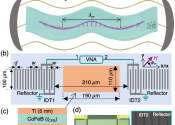'Shear sound waves' provide the magic for linking ultrasound and magnetic waves
A team led by researchers from the RIKEN Center for Emergent Matter Science in Japan has succeeded in creating a strong coupling between two forms of waves—magnons and phonons—in a thin film. Importantly, they achieved ...









